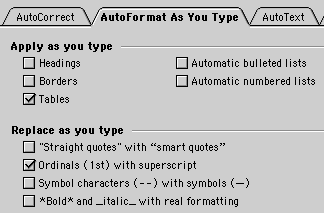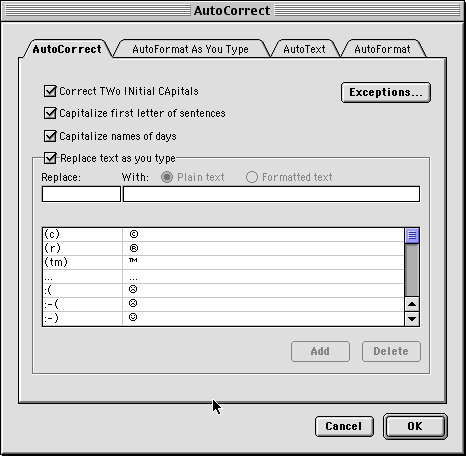|
||||
Email -- Say it with feelingWritten and published December 15, 1999 Last week I promised the end of the serious spam stuff and said we'd move on to some lighter, fun stuff this week. Since more helpful responses have poured in about spam, you can expect an extra reader comments column soon. Meanwhile, on to some fun... When we speak, our voice's tone and inflection are a large part of our message. So is our laughter when something is fun. When we speak to one another face to face our facial expressions, such as a smile or knitted eyebrows add to our message. When we hand-write letters, the flow of our handwriting, size of print, bold characters and such, have to communicate what cannot be heard from our voices or seen from our faces. When we type a letter in a word processor, we get to use different font faces, font sizes, italics, bold, and perhaps color in lieu of a voice or facial expression -- but what about e-mail? E-mail -- that is, standard by-the-book e-mail -- carries no voice, is not face to face, and doesn't have font sizes, font styles, color, italics or bold. The standard one font face, one size, one color, one style e-mail is, in effect, emotionless. But people are not emotionless. Communication between human beings often carries emotion. Sometimes the written words alone can convey that emotion. For example, when we're helping someone on a list we can assure the person that his/her question wasn't dumb, say that we learned the hard way too, then offer the solution. But there are often times when words alone are not the full message. Take, for example, the phrase, "That was so funny." With laughter that's commendation and we agree something was funny. With sarcasm it becomes a response to something that wasn't funny at all. And sometimes those same words can carry anger at what was done. When communication between people is reduced to the plain typed characters of the alphabet, messages can easily be misconstrued. I, myself, have thought people on e-mail lists were being rude when it turned out they intended to be light-hearted and funny. Fortunately, mankind is ingenious and always seems to come up with new ways to communicate. Once upon a time man invented speech. Later he invented the phone. And in this decade, man reinvented the typewritten word and invented the emoticon. This column is more that just for fun. It can save you from a virtual punch in the face, or help you save face. Use what you learn here to punctuate your e-mail so the true meaning rings clear when recipients read it. New uses for old charactersRemember when capitol letters were the way children learned to write? Well, actually they still are. But nowadays if that child types in all caps in e-mail he'd be shushed in the virtual library for yelling. In e-mail, words in capitol letters represent yelling. Use them only for serious emphasis. Remember the old typewriter days when the asterisk (*) was used to denote points? That was before the "real" bullet (o) (option-8) became available to us sophisticated Mac users. But what do you do with an asterisk when it stops being an asterisk? (Anyone else see "White Christmas this week?) In today's modern age, you give it a new lease on life, denoting bold. What *do* I mean? I mean that "do" was just bolded for emphasis as I spoke ... er, wrote. Asterisks can also be used similar to brackets, to show motion or action, such as *nod.* (Thanks to Michelle Steiner for adding this fact.) The underline is another character that needed a new position in our lives ever since highlighters replaced underlining in text books and leader tabs replaced it for creating lines in word processing. The underline character, known as the "underscore" now denotes italics.
In case you're wondering, here's the preference dialog. It's under Tools->AutoCorrect. Virtual EmotionsHave you ever received an e-mail from someone that contained words between the angle brackets? You may recognize that those brackets are used to enclose HTML tags (which are web browser instructions). For example, the HTML code, "<H1>" tells the browser to render a main level heading. But before there was HTML, these brackets set aside virtual emotions in the world of the BBS. A common example is <g> which stands for "grin." It's a way of adding a smile to your words. These days so many of us are code geeks that this tag format has become a regular way of life in our <rant> I can't believe they're holding New Year's on December 31st again! When will they hold it in June for once? Why can't August be New Years? Why does December get to have all the fun? </rant> The "/" that comes before the closing tag shows HTML to end that formatting. FWIW, IMHO, abbreviations save timeDoes that heading need translation? It says, for what it's worth, in my humble opinion, abbreviations save time. They also save your finger muscles. Abbreviations take on a life of their own. You'll find there are several commonly used abbreviations flying through cyberspace. Here are some of the most common in everyday e-mail.
Besides seeing abbreviations in e-mail, you'll see them and use them in online chats. These are, I confess, lifted from World Without Borders (http://www.worldwithoutborders.com) -- a cool chat site created and run by my friend Cys (Cease). BTW, if you're not familiar with it already, I recommend checking it out. There are lots of great Mac chats both live and archived. (Guess who chatted on Dec 6th.)
Perhaps the funniest invention of Internet speak is the emoticon. The person who started this had to have been a child of the 70's, haunted for life by the bright yellow smiley face that graced just about everything for too long a while -- after the love bug flower ran its course. You might say you've gotta put a new slant on life when you read these. They only make sense sideways. Need a smile? Speaking in friendly fun. Enjoying someone's witty words. Here's smiling at ya. :) Want more than a smile? How about a wink along with it? ;-) The very e-mail that invited me to write for MacCentral showed me this would be a fun crowd to hang with. Notice the subject.
Not happy with something or someone? A frown will show them. :(
Note: Word 98 also translates smileys unless you tell it not to. Try typing ":)" and then a space to see what I mean. Here's the preference dialog for this. Again, it's under Tools->AutoCorrect.
There are many variations and other emoticons, although recipients are not likely to understand them. You'll find many more obscure ones at WorldWithoutBorders.com if you follow a Chat Lingo button somewhere along the sign up road. Next WeekNext week I think we'll finally get around to discussing e-mail attachments: why and how. |
||||
 Word 98 has an option that automatically converts these formats. For example, with the option pictured here turned on, try typing: "Wow! This *is* cool. Actually, it's _amazing!_" You'll see the asterisk turn text bold and the underscore turn text italic.
Word 98 has an option that automatically converts these formats. For example, with the option pictured here turned on, try typing: "Wow! This *is* cool. Actually, it's _amazing!_" You'll see the asterisk turn text bold and the underscore turn text italic. 
